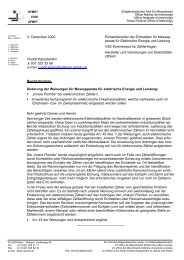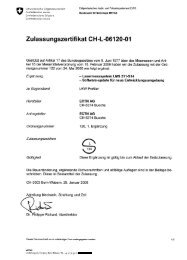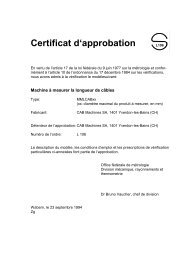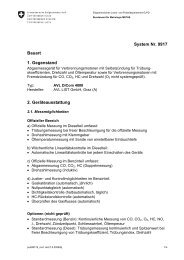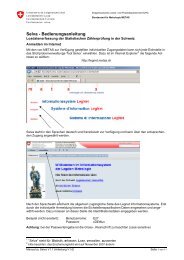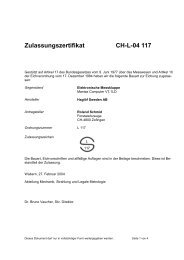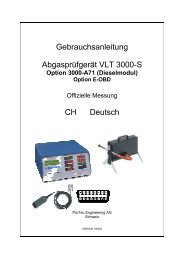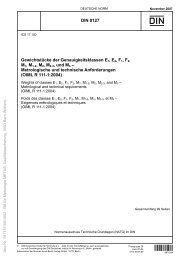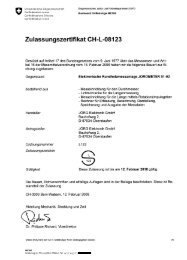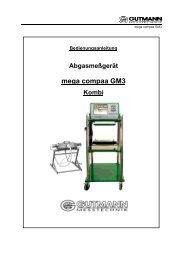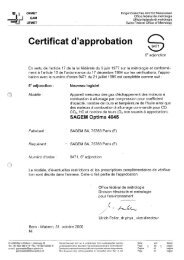Create successful ePaper yourself
Turn your PDF publications into a flip-book with our unique Google optimized e-Paper software.
3. General information<br />
3.1 Application<br />
The RTM 430 smoke opacity module serves the measurement of<br />
emissions (smoke emission) for diesel vehicles.<br />
The RTM 430 can only be used in conjunction with the following<br />
device versions:<br />
– Emission System Analysis (ESA),<br />
– Bosch Emissions Analysis (BEA) or<br />
– Emissions Analysis Tester (EAM).<br />
3.2 Terminology<br />
The effective measuring length is the light distance, which is<br />
passed through by the smoke. It amounts to 430 mm.<br />
The degree of opacity [%] and coefficient of absorption<br />
[1/m] represent a dimension for the quantity of light, which is<br />
weakened (absorbed) by soot, white smoke and blue smoke.<br />
The mass concentration [mg/m 3 ] indicates the particulate<br />
volume in mg, which is emitted by diesel vehicles in relation to<br />
1 m 3 of exhaust gas.<br />
i<br />
Conversion of the coefficient of absorption into mass<br />
concentration is based on the conversion table compiled by<br />
the British Motor Industry Research Association (MIRA).<br />
4. Delivery specification<br />
RTM 430 - 1 687 022 413:<br />
– RTM 430 connecting cable (6 m)<br />
– Car exhaust-sample probe<br />
– Exhaust-sample hose, Ø 10 mm, length 1 m<br />
– Calibration pin<br />
– Cleaning brush<br />
– Operating instructions<br />
– Installation instructions<br />
RTM 430 –1 687 022 599:<br />
– Cleaning brush<br />
– Operating instructions<br />
– Installation instructions<br />
5. Functional description<br />
The RTM 430 serves the recording of the coefficient of absorption<br />
k [1/m] of the exhaust gas for compression ignition engines<br />
(diesel engines). To this end, during the measurement, while<br />
accelerating, a portion of the exhaust gas from the vehicle’s<br />
exhaust tailpipe is routed via an exhaust-sample probe and a<br />
measuring chamber sample hose (without any suction support).<br />
The opacity is measured, which in turn is used to calculate the<br />
coefficient of absorption.<br />
Exhaust-sample probe:<br />
– The exhaust sample probes are designed such that exhaust<br />
sampling can be conducted on all the various shapes of exhaust<br />
tailpipes. The adjuster mechanism enables a minimum<br />
immersion depth into the exhaust pipe of 5 cm to be assured.<br />
– Furthermore, the design also ensures that a minimum distance<br />
of 10 mm to the inner exhaust-pipe wall is given.<br />
Measuring chamber:<br />
– In order to measure the opacity an optical sender (LED) emits<br />
green light, which is partly absorbed by the exhaust gas in the<br />
measuring chamber.<br />
– The non-absorbed portion of light arrives at the receiver<br />
(photodiode) and converts the optical signals into electronic<br />
data.<br />
– Soot deposits at the optical windows are avoided by means of<br />
air curtains (blow-by purge air).<br />
– In order to avoid having any condensation on the walls of the<br />
measuring chamber and to keep the exhaust-gas temperature<br />
above the dew point, the measuring chamber is equipped with<br />
a heater.<br />
– The null compensation runs automatically.<br />
Correct operation:<br />
– In order to guarantee correct operation, the exhaust-gas<br />
temperature and the measuring chamber temperature are<br />
constantly monitored.<br />
– In addition to this, prior to each measuring cycle a null<br />
compensation process is performed, whereby the<br />
contamination level of the optical measurement path is also<br />
checked.<br />
Measurement can no longer take place if one of the stated<br />
parameters is outside the permissible tolerance.<br />
16



